CHEVROLET S10 1997 2.G Owners Manual
Manufacturer: CHEVROLET, Model Year: 1997, Model line: S10, Model: CHEVROLET S10 1997 2.GPages: 402, PDF Size: 21.04 MB
Page 281 of 402
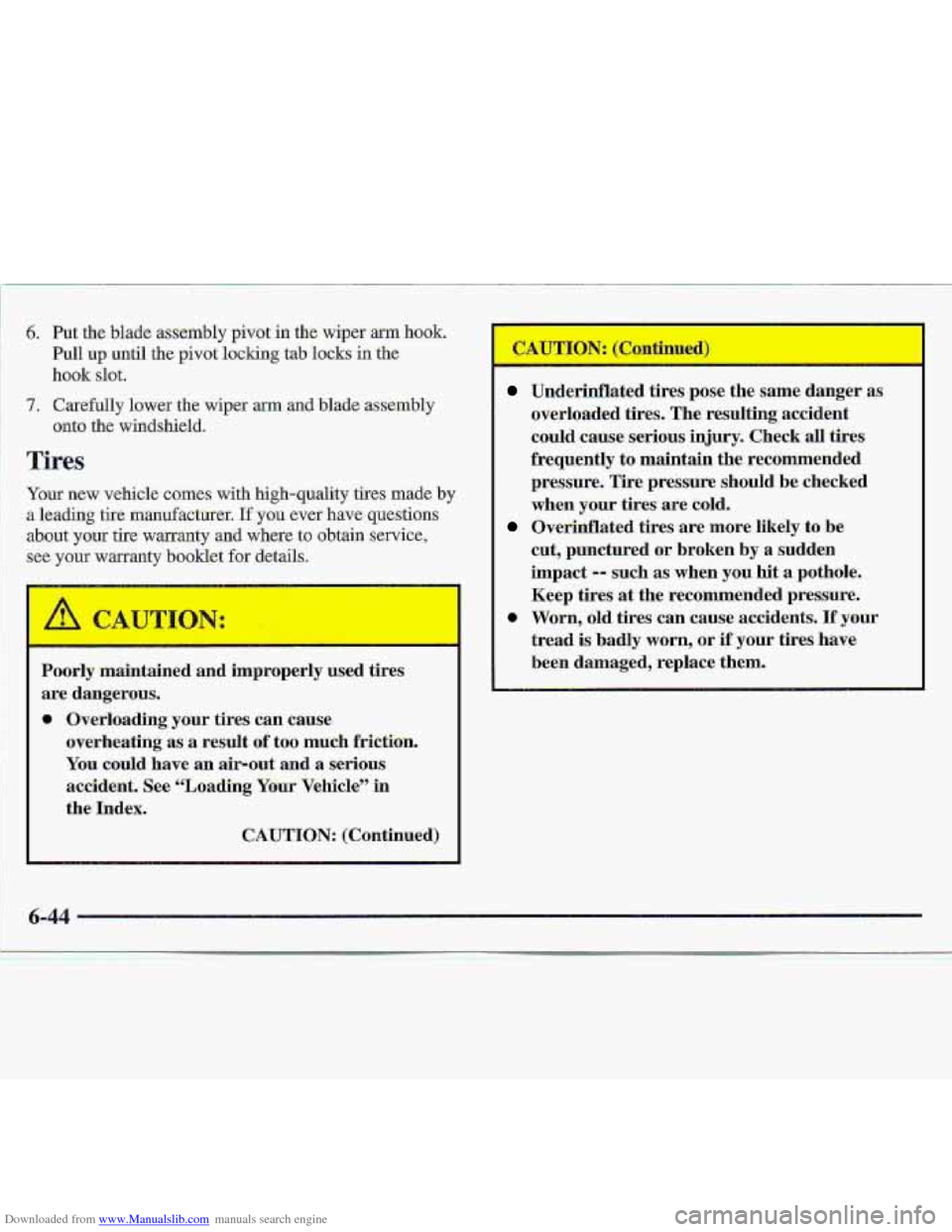
Downloaded from www.Manualslib.com manuals search engine 1 F
Poorly maintained and improp-erly used tires
are dangerous.
0 Overloading your tires can cause
overheating as a result
of too much, friction.
You could have an air-out and a serious
accident. See “Loading Your Vehicle” in
the Index.
CAUTION: (Continued)
Unaerinflated tires pose the same danger as
overloaded tires. The resulting-accident
could cause serious injury. Check all tires
frequently to maintain the recommended
pressure. Tire pressure should be checked
when your tires are cold.
cut, punctured
or broken by a sudden
impact
-- such as when you hit a pothole.
Keep tires at the recommended pressure.
0 Worn, old tires can cause accidents. If your
tread
is badly worn, or if your tires have
been damaged, replace them.
Overinflated tires are more likely to-be
6-44
Page 282 of 402
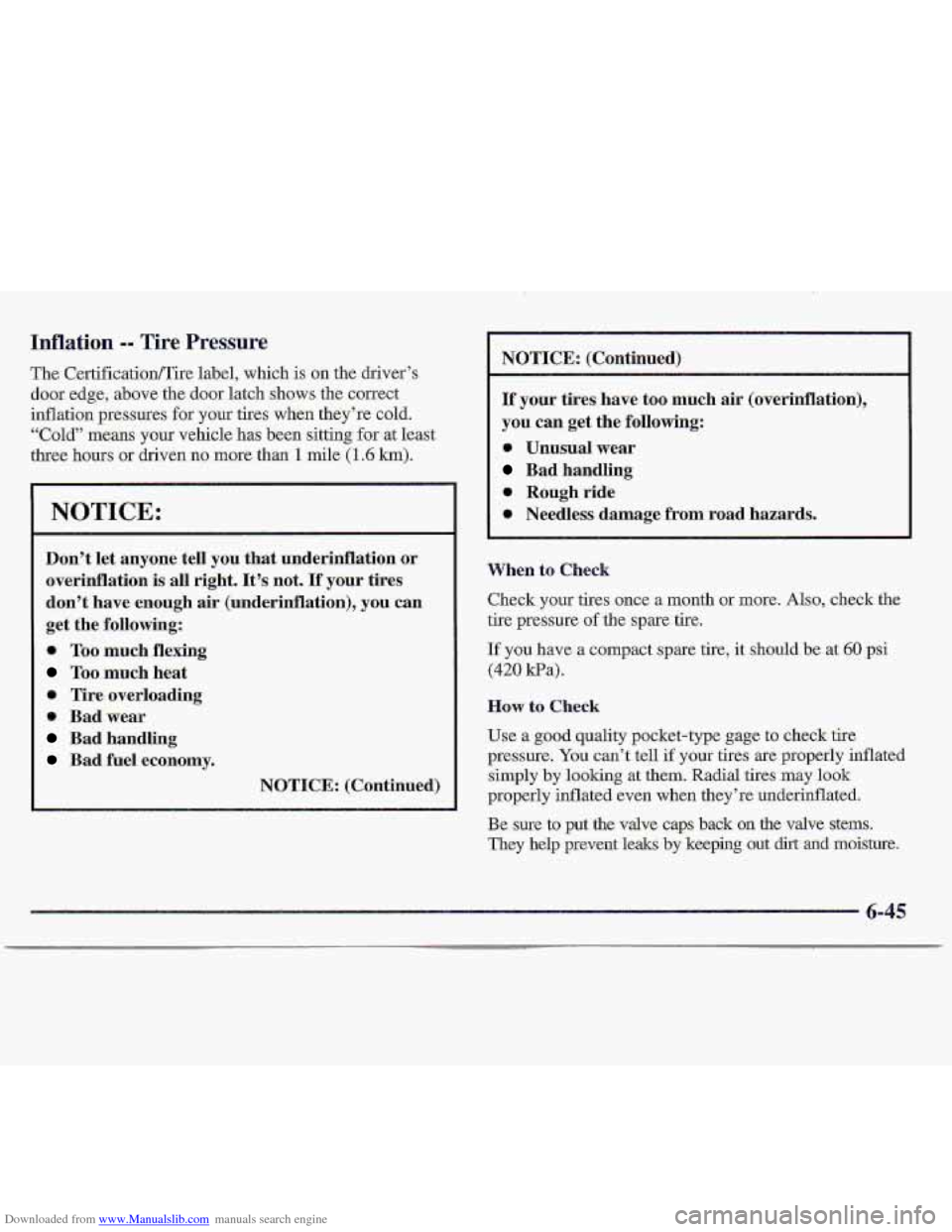
Downloaded from www.Manualslib.com manuals search engine Inflation -- Tire Pressure
The CertificationlTire label, which is on the driver’s
door edge, .above .the door latch shows the correct
inflation pressures for your
tires when they’re cold.
“Cold” means your vehicle has been sitting
for at least
three hours
or driven no more than 1 mile (1.6 km).
NOTICE:
Don’t let anyone tell you that underinflation or
overinflation is all right. It’s not. If your tires
don’t
have enough air (underinflation), you can
get
the following:
Too much flexing
Toa much heat
@ Tire overloading
0 Bad wear
Bad handling
Bad fuel economy.
NOTICE: (Continued)
NOTICE: (Continued)
If your tires have too much air (overinflation),
you can get the following:
9 Unusual wear
Bad handhg
0 Rough ride
1) Needless damage from road hazards.
When to Check
Check your tires once a month or more. Also, check the
tire pressure
of the spare tire.
If you have a compact
spare tire, it should be at 60 psi
(420 kPa).
How to Check
Use a good quality pocket-type gage to check tire
pressure.
You can’t tell if your tires are properly inflated
simply by looking at them. Radial tires may
look
properly inflated even when they’re underinflated,
Be sure to put the valve caps back on the valve stems.
They help prevent leaks by keeping out dirt and moisture.
6-45
Page 283 of 402
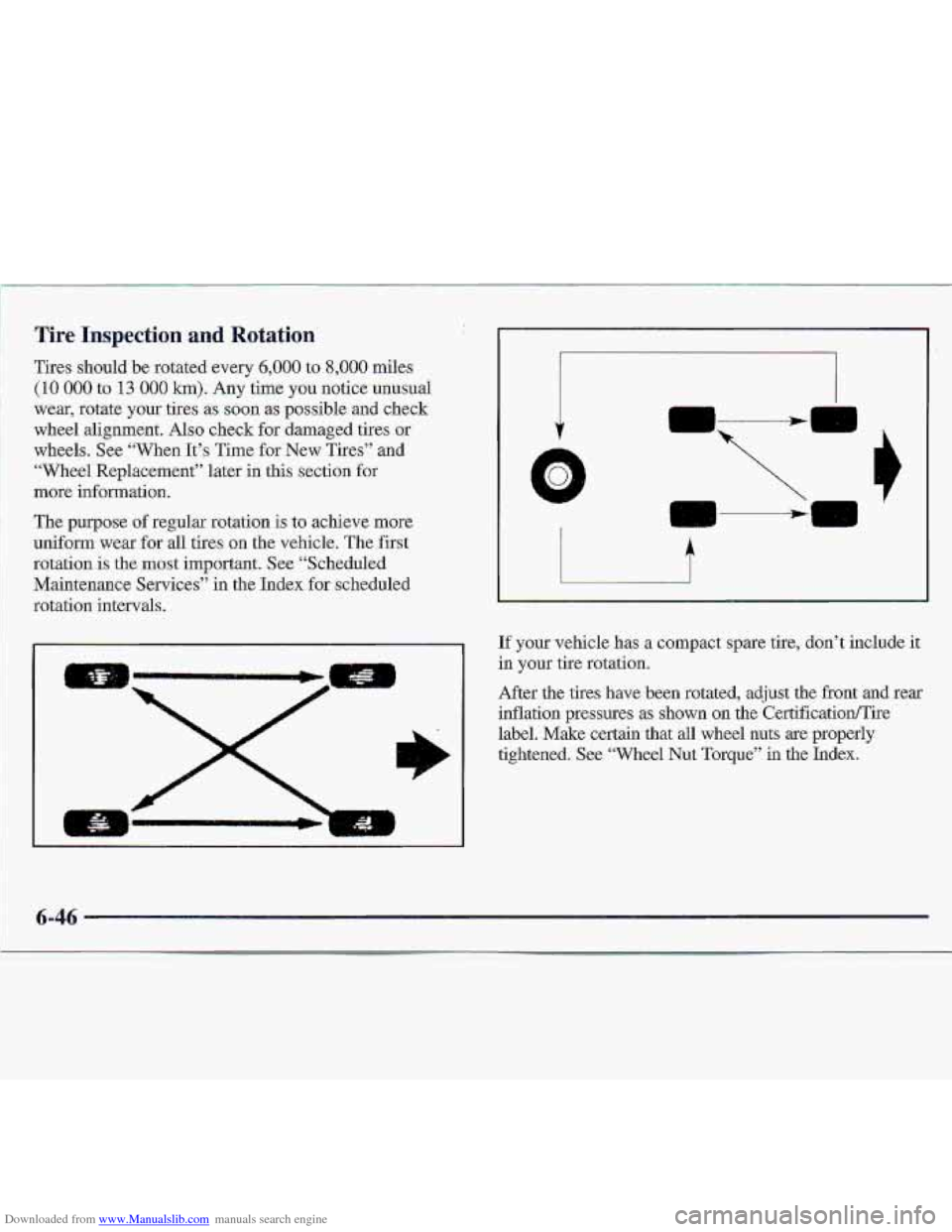
Downloaded from www.Manualslib.com manuals search engine Tire Inspection and Rotation
Tires should be rotated every 6,000 to 8,000 miles
(10 QOO. to 13 0.00 km). Any time you notice unusual
wear, rotate your tires
as soon as possible and check
wheel alignment. Also check for damaged tires or
wheels. See “When
It’s Time for New Tires” and
“Wheel Replacement” later in this section for
more information.
The purpose
of regular rotation. is to achieve more
uniform wear for
all tires on the vehicle. The first
rotation is the mast important. See “Scheduled
Maintenance Services”
in the Index for scheduled
rotation intervals.
If your vehicle has a compact spare tire, don’t include it
in your tire rotation.
After the tires have bea rotated, adjust the front
and rear
inflation. pressures
as shown on the Certificatioflire
label. Make certain that all wheel nuts
are. properly
tightened. See “Wheel Nut Torque” in the Index.
6-46 ,,,. .. -~I
Page 284 of 402
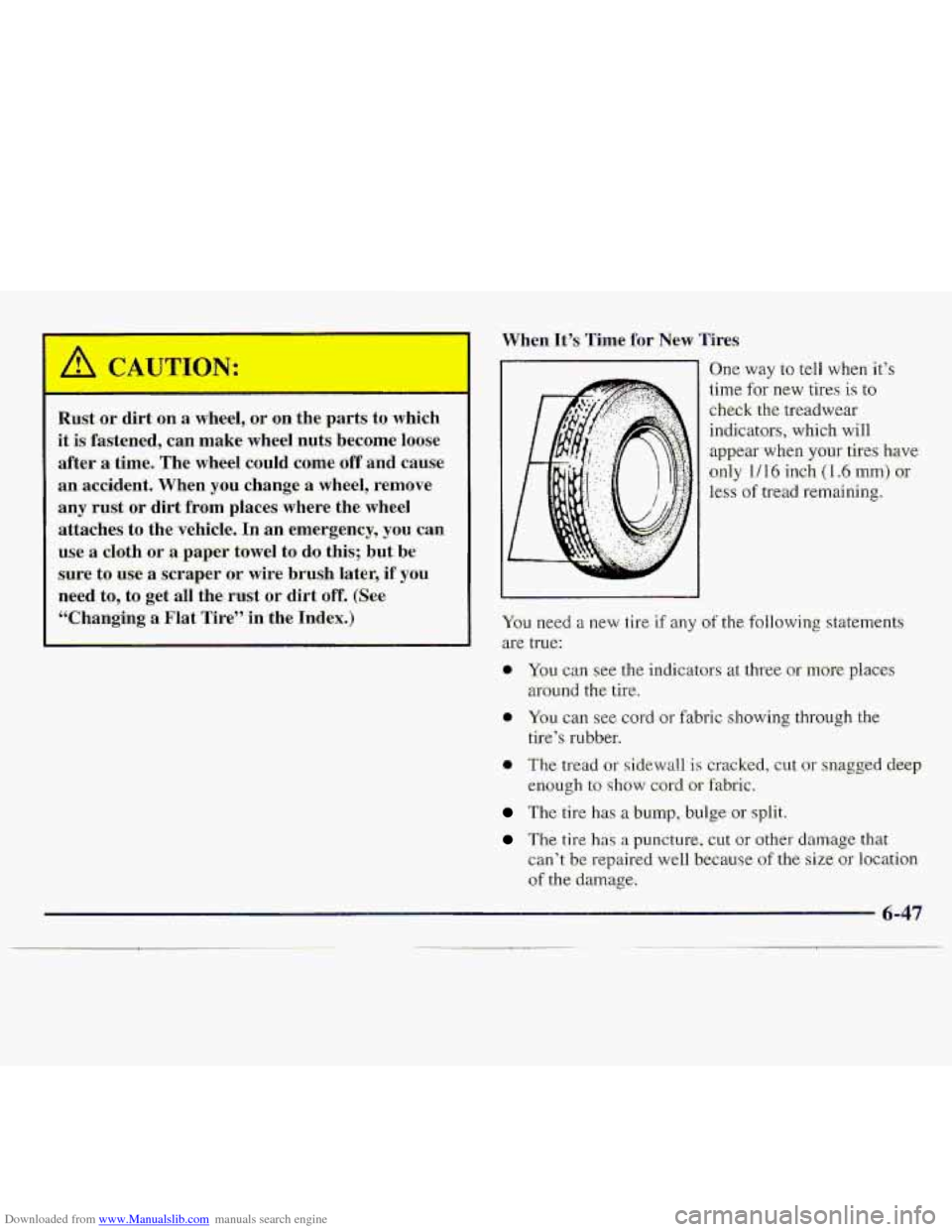
Downloaded from www.Manualslib.com manuals search engine When, U’s Time for Nk-W Tires
Rust-or dirt on a wheel,. or on the parts to which
it is fastened, can make wheel nuts bec:ome lo-ose
a-ftep a. time. The wheel coukd come off and cause:
an accident. When you change a wheel, remove
any .rust or dirt from places where the wheel
attaches
to the vehicle. In an emwgency, you can
use a cloth or a paper: towel to do this; but be
sgre to use a scraper or wim brush later, if you
need to, to get all the rust or dirt off. (See
“Changing a Flat Tire” in .the Index.)
One way to tell when it’s
time
for new tires is to
check the treadwear
indicators, which wil’l
appear when yo-ur tires have
only l/ 16 inch (1.6 mnm) or
less of tread remaining.
10 You can see the indicators at three 01: mn1-e places
around. thetire-.
a You can see cord .or f’abric showing through the
tire’s rubber.
The tread or sidewall is cracked, cut or snagged deep
enou.gh to show cord-or fabric.
The tire has a bump, bulge or split.
The tire hn.s a puncture, cut or other damage that
can’t be repaired well because of the size 01: :location
of the damage.
Page 285 of 402
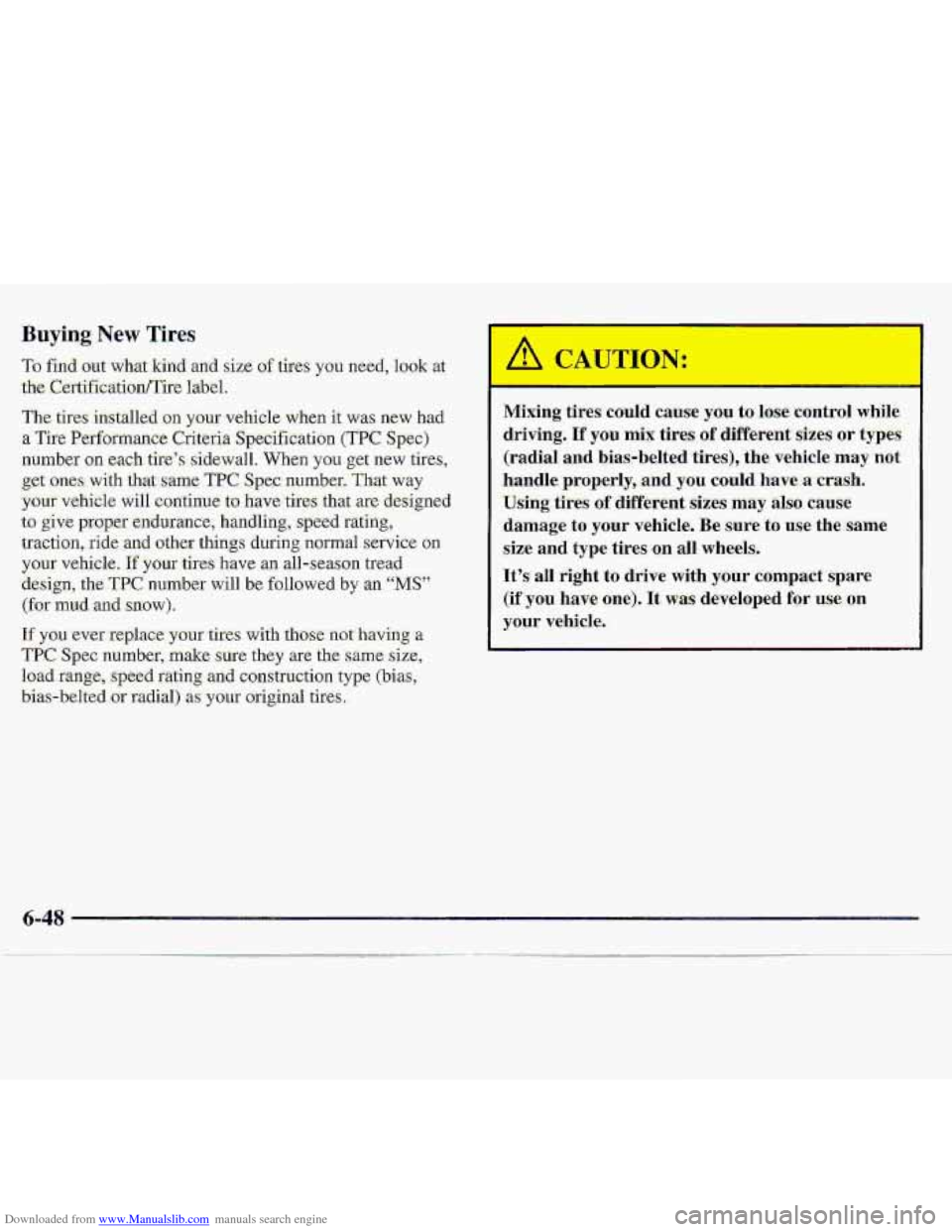
Downloaded from www.Manualslib.com manuals search engine Buying. New Tires
'If you 'eve.r replace your tires with those- not :having .a
TPC Spec number, make Sure they are the same, size,
load range, speed rating and construction type (bas,
.bias-belted..or radial) as you^ original tires..
Mixing tires could 'cause you to lose control while
driving. If
you mix tires of different: sizes or type-§
(.radial and bias-belted tires), the vehicle may not
handle properly, land you could have .a crash.
Using,tires of different sizes may also cause
.damage to your vehicle. Be sure to use the:.same
size and type tires on all wheels.
It's
all right to drive with your compact spare
(if .you have one), It was developed for use on
your vehkle.
6-48
Page 286 of 402
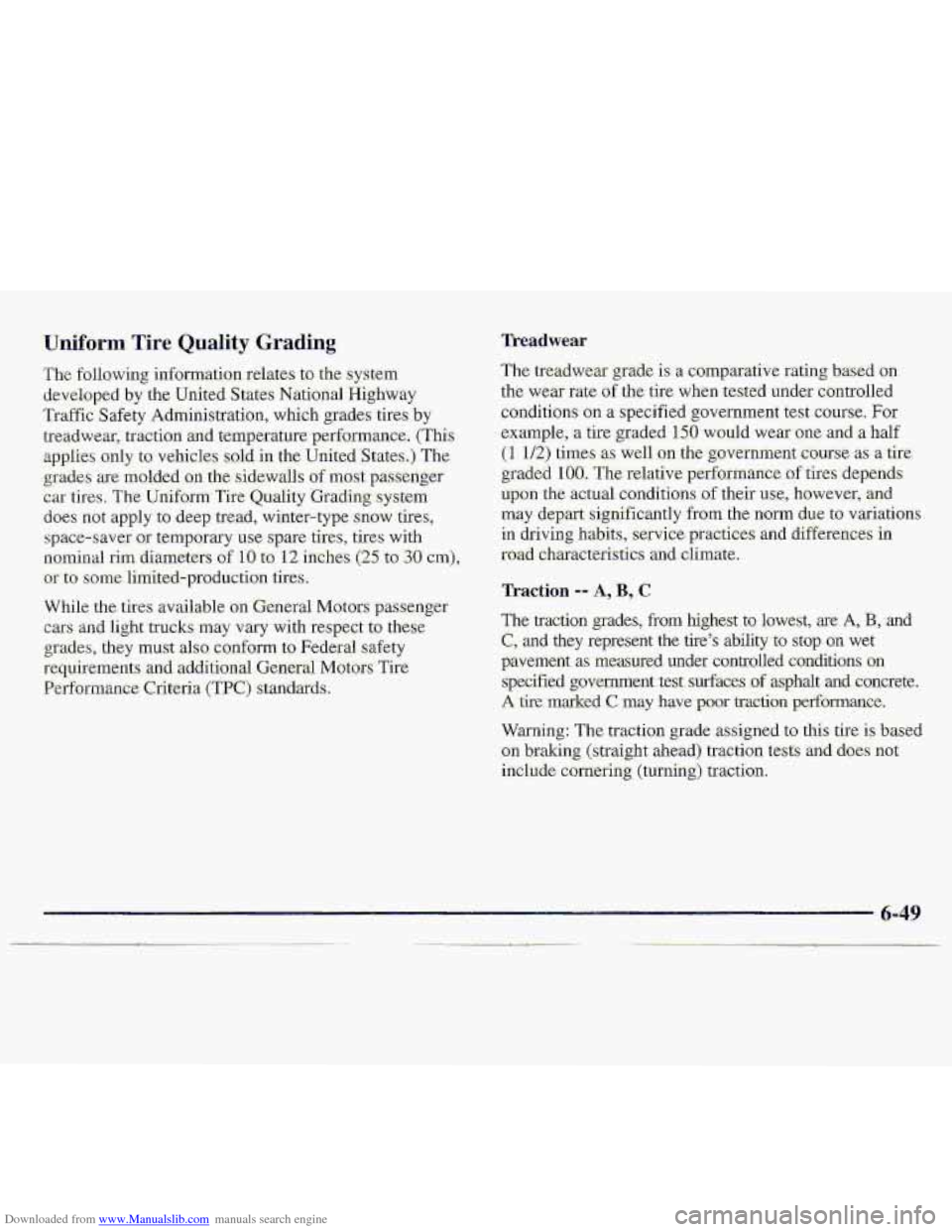
Downloaded from www.Manualslib.com manuals search engine While the tires available on General Motors passenger
cars and light-trucks may vary with respect..to these
requirements and additional General Motors Tire
Performanc.e Criteri-a (TPC) standads.
e: orades, . they must also. conform to Federal safety
Warning: .The tract-ioa grade assigned to thi.s .tire is based
,on brakin.g (straight ahead) tractioli tests and- do.es not
include
comering (tuning3 tractioh.
Page 287 of 402
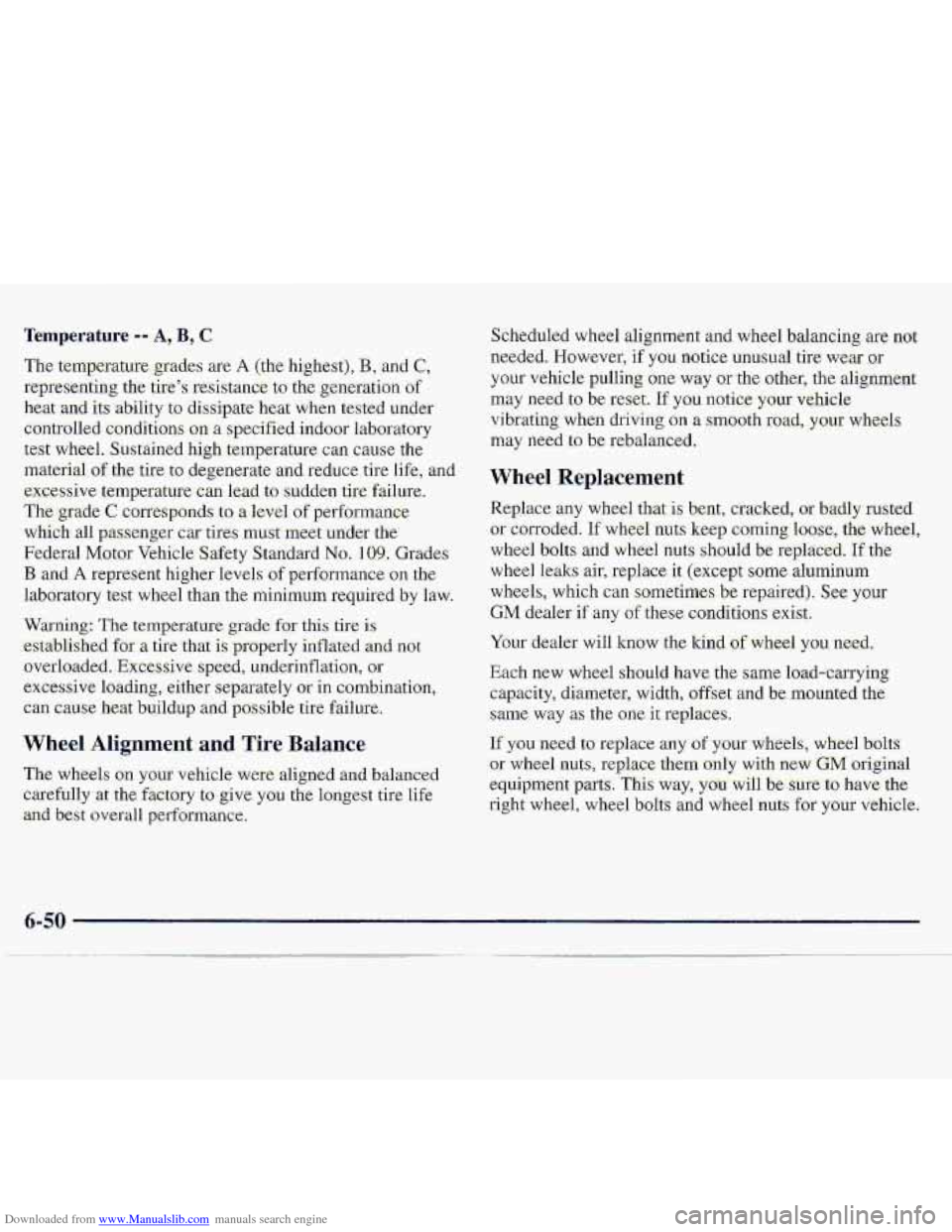
Downloaded from www.Manualslib.com manuals search engine Temperature -- A, 33, C
Warning: 'The temperature grad.e for this tire is
estab1ishe;d for' a-tire that i.s properly inflated .and not
overlaaded. Excessi-ve speed, underinflation, or
excessive loading, either separately or in combination,
can cause heat bui1.d.up and. pes-sible tire failure,
Scheduled wheel alig-nment an.d wheel balancing are not
needed. However,
if y0.u notice unusual tire wc;ar or
yo?ur vehicle pulling. ode way or -the o,t.her, the alignment
may need to b.e met. If y~u notice your vehicle
vibrating.
when driving on a smooth road, your wheels
may need to be rebalanced.
Wheel Replac-ement
The whWs on your vehicle were'aligned and balanced
carefully at the factory to give.you the longest tire life
and best overall perf~rrnance.
6-50
Page 288 of 402
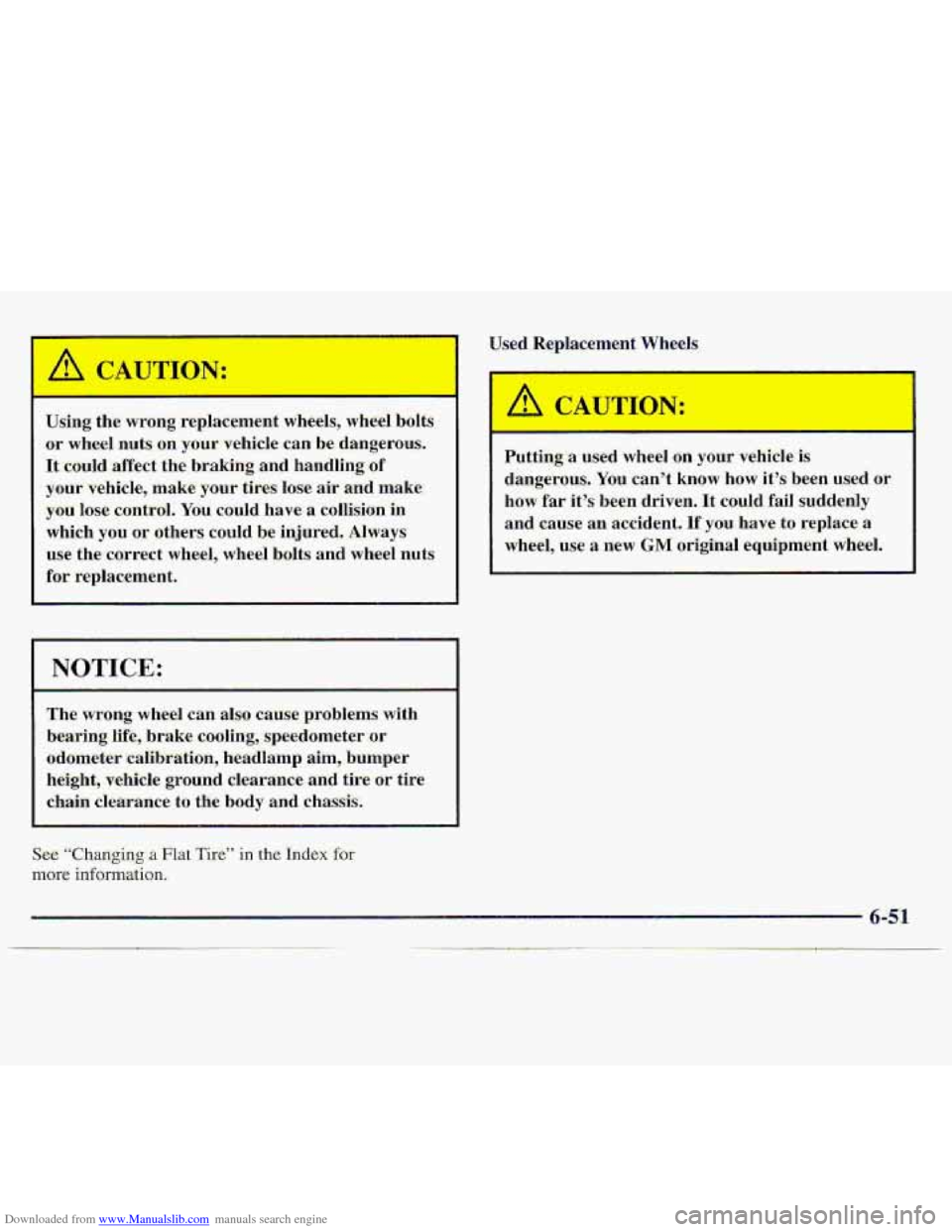
Downloaded from www.Manualslib.com manuals search engine Using the wrong replacement wheels, wheel bolts
or wheel nuts on your vehicle can be :d.angerous..
It could affect the braking and handling
of
your vehicle, make your tires lose air and make.
you lose contrd. You could have a~c.olliSioh in
which you or others could be injured. Always
use the.correct wheel, wheel b;olts and wheel nuts
for replacement.
The wrong wheel can also cause pro-blems with
hearing life, brake cooling, speedometer
or
odometer ‘calibration, headlamp aim, bumper
hei.ght, vehicle
ground clearance and tire or tire
chain clearance
to the body and .chassis;
See “Changing a Flat Tire” : Index for
more infmm.abn.., ..
* *
Used Replacement Wheels
r
Putti ; ,a used wheel on your venicIe is
dangerous.
You can’t know how id’s been used or
how
far it’s been driven. It could fail suddenly
and cause
an accident. E you have to replace a
wheel, use a new GIC’I. original equipment wheel.
Page 289 of 402
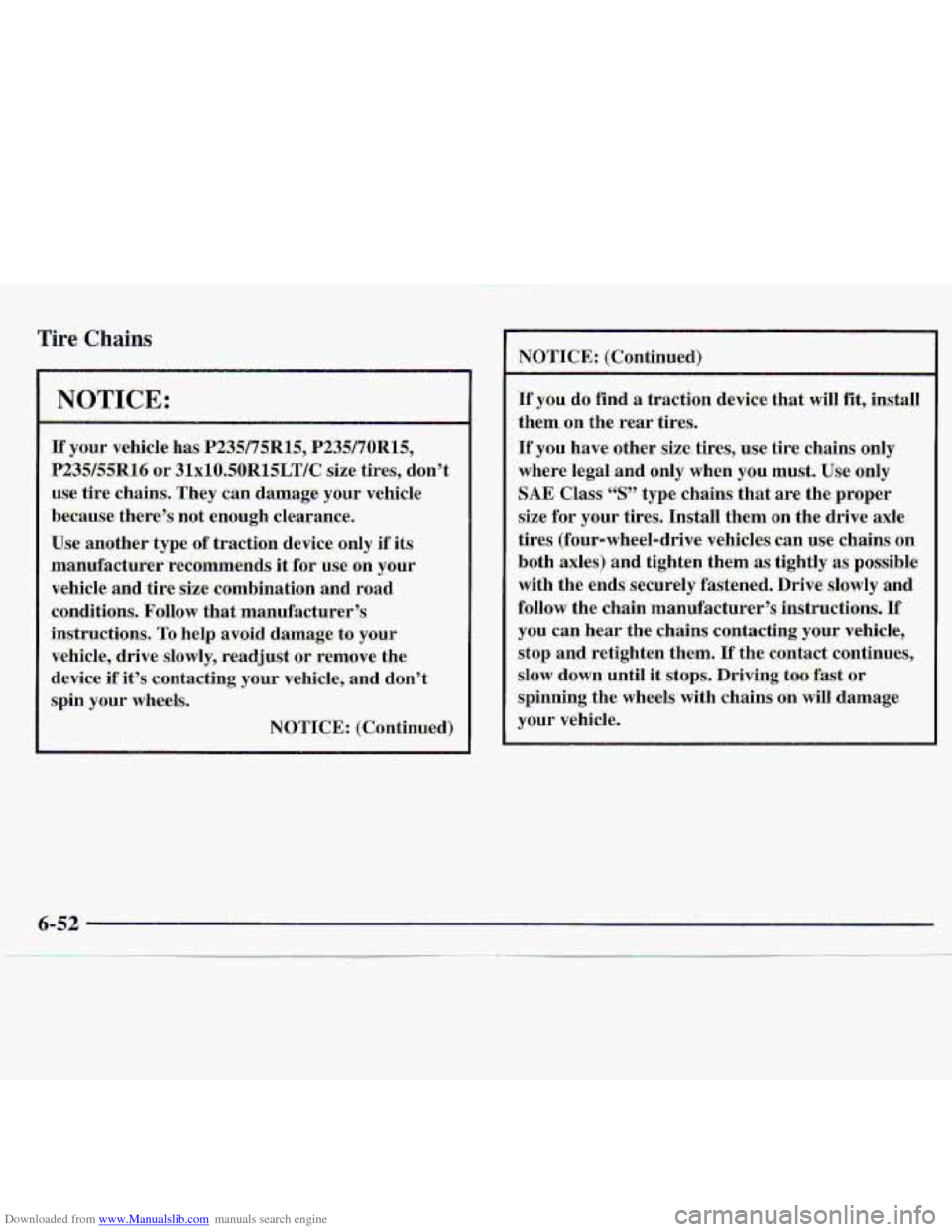
Downloaded from www.Manualslib.com manuals search engine Tire, Chains
use tire chains. They can damage your vehicle
because there’s not enough clearance.
Use another type
of traction device only if its
manufacturer recommends it
for use on your
vehicle and tire size combination and road
conditions. Follow that -manufacturer’s
instructions.
To help avoid damage to your
vehicle, drive slowly, readjust or remove the
device if
it’s contacting your vehicle, and don’t
spin your -wheels..
NOTICE: (Continued)
’ NOTICE: (Continued)
If you do find a traction device that will fit, install
them on the rear4irgs.
If you have other size tires, use tire chains only
where legal and only when you
must. Use. only
SAE Class “S” type chains that are the proper
size
for your tires. Install them on the drive axle
tires (four-wheel-drive vehicles. can use chains on
both axles) and tighten them as tightly as possible
with the ends. securely fastened. Drive slowly
and
follow the chain manufacturer’s instructions. If
you can hear the chains contztc,ting your vehicle,
stop and retighten them.
If the contact contimes;
slow down until
it stops. Driving toa fast or
spinning the wheels with chains on will damage
your vehicle.
Page 290 of 402
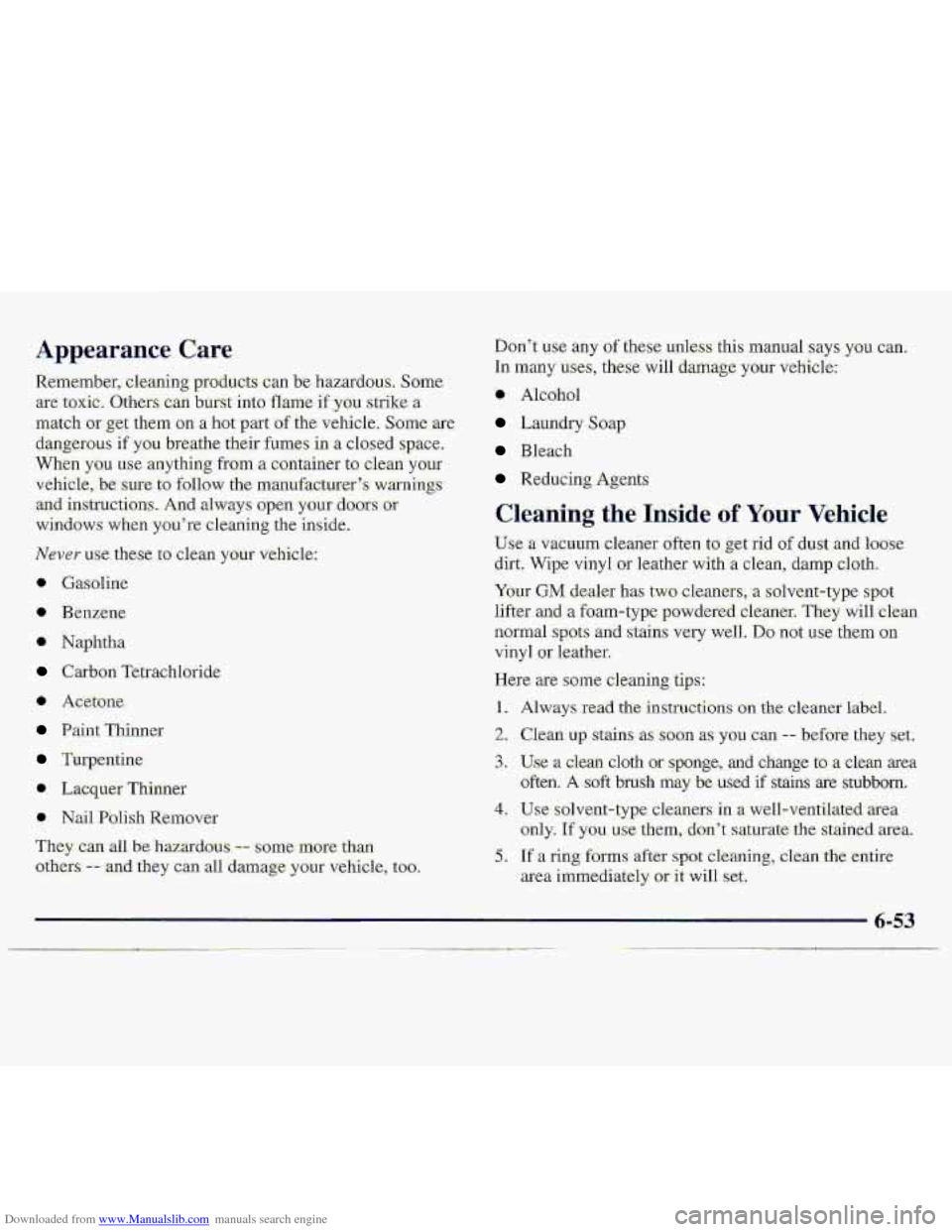
Downloaded from www.Manualslib.com manuals search engine Appearance Care
R.emernkr, cleaning producrs can b’e hzardous. Some:
are tQxic. Others can bwst ir~to. flame if YOU slrike -a-
match or get them on a hot part of the veh-ide. Some are
dangerous if
yau breathe their- fumes in ,a clo.sed space.
Wlie11 you use anything fram a co&t.ainer to clean your
vehicle,
b.e sure to follow the manufacturer’s warnirigs-
-and instruc.tiam. And always open your doors or
windows when you’re cleaning the i,nsi.de.
..
Never use’ these to clean your vehicle:
e Naphtha
Carbon Tetrachloride
Paint Thinner
Turpentine
@ Lacquer Thinner
@ Nail Pb1is.h Remover
They can all be. hazardous. -- some-mare- than
others -- and they can all damage .. your vehicle, too.
Don’t use any of these unless this manual says-,yQu can.
In many uses, these will damap yciur vehicle:
* Alcohd
Laundry Soap
Bleach
Reducing Agents
Cleaning the Inside of Your Vehicle
Use a vac.um cleaner often to geb-r-id of dust and loose
dirt. Wipe vinyl or leather with a clean, damp cloth.
6-53